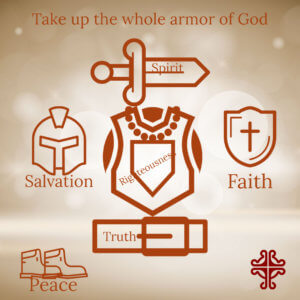
Peace Shoes and Pearls
 Everlasting life and the kingdom of God are tough ideas to get your mind around. Over the past few weeks, we’ve focused on Jesus’ tough teaching in John’s gospel. Each week, the gospel message has been that Jesus is the bread of life — whose body connects all who believe in him and follow his teachings to God. The message is that following Jesus — Jesus’ teaching and way of life — is the sustaining source of what we need to connect with each other and to God — the goodness that really matters. Jesus’ message is hard to hear, and even more difficult to understand. We see that in the disciples’ and the crowd’s responses in John’s gospel over the past three Sundays. They’re confused, which models for us that the idea Jesus is trying to communicate is both really difficult to understand and really, really important.
Everlasting life and the kingdom of God are tough ideas to get your mind around. Over the past few weeks, we’ve focused on Jesus’ tough teaching in John’s gospel. Each week, the gospel message has been that Jesus is the bread of life — whose body connects all who believe in him and follow his teachings to God. The message is that following Jesus — Jesus’ teaching and way of life — is the sustaining source of what we need to connect with each other and to God — the goodness that really matters. Jesus’ message is hard to hear, and even more difficult to understand. We see that in the disciples’ and the crowd’s responses in John’s gospel over the past three Sundays. They’re confused, which models for us that the idea Jesus is trying to communicate is both really difficult to understand and really, really important.
In our gospel readings over the past three Sundays, Jesus teaches us the need to fully embody — eat right up — his teaching and way of love to have everlasting life. We need to become what we pray and practice as Christians. To get this point across, Jesus uses the shocking metaphor of eating his body and drinking his blood, mentioned 7 times in this one story when cannibalism was unknown in the Ancient Near East in the first century.
Just in case we’re not paying attention, the crowd brings us up short: In John’s gospel we talked about last week, the crowd starts to murmur and grumble, saying, How can this man give us his flesh to eat? And then in John’s gospel today, the disciples themselves say to Jesus, this is tough teaching. Who can accept it? Many of them can’t, as we heard today, and they leave. This is tough teaching, and sometimes when Jesus’ metaphors are hard to understand, that’s a cue that we need to lean in close. There are great rewards — as much as everlasting life — in a closer look, and a prayerful, curious attempt to understand.
Ephesus
Today, Paul’s letter to the Christians in Ephesus, a prosperous Roman port city in Asia Minor — modern day Turkey — has another really difficult metaphor. We’ll get to that in a minute, but first it’s important to remember Paul’s own context. Paul was both a Jew and a Roman citizen. He persecuted Jesus’ early followers but then had a vision, converted and was probably the greatest single force in the development and spread of Christianity. Paul traveled all over Judea, then to Syria, Cyprus, Asia Minor, Greece, and Rome, visiting communities and sharing Jesus’ teachings. Where Jesus’ ministry was rural — around the Sea of Galilee, and filled with images of sheep, grapes, fields, and vineyards, Paul visited communities along trade routes, and Christianity spread quickly through his urban mission. He’d move on to the next town to teach again, but he checked back, helping the communities with real problems and real questions that came up in their communities as they tried to live as Christians.
Many scholars believe that the Letter to the Ephesians was actually written by another Christian missionary imitating Paul. There is also evidence that the letter was not written specifically for the Christians in Ephesus but was written to be delivered to any Christian community that was having similar problems. Scholars think this is true because there are no personal greetings in the letter to individuals Paul knew from his time in Ephesus, or specific details in the letter about the community itself.
So what was the problem in the Christian community? This may surprise you! The Christians were not getting along with each other. They had different ideas about how to live together, who was in charge, how they’d make decisions, and how they’d worship. And like Jesus teaches us to embody his teachings of peace and love with the shocking metaphor of eating his body and drinking his blood, Paul makes his point by putting what seems like two opposite ideas together. In our reading today, Paul tells the community of disagreeing Christians NOT to do nothing and just act peaceful, BUT to fight with their very lives for peace.
 Wait, what? Yes, Paul says, Put on the whole armor of God as a defense against Satan’s attacks. This armor includes the belt of truth, the breastplate of righteousness, the shield of faith, the helmet of salvation, and the sword of the Spirit. And for shoes, put on the peace that comes from the Good News so that you will be fully prepared. Put on your Peace Shoes! I’m not sure what Peace Shoes look like, but I wore my Keds today, today to stay ready for action, because peace and love are active CHOICES, not inaction.
Wait, what? Yes, Paul says, Put on the whole armor of God as a defense against Satan’s attacks. This armor includes the belt of truth, the breastplate of righteousness, the shield of faith, the helmet of salvation, and the sword of the Spirit. And for shoes, put on the peace that comes from the Good News so that you will be fully prepared. Put on your Peace Shoes! I’m not sure what Peace Shoes look like, but I wore my Keds today, today to stay ready for action, because peace and love are active CHOICES, not inaction.
So how can this full battle dress be about peace? Even if you put on peace shoes, like Paul says, what about all the war dress — that fighting fashion ensemble? The Armor of God, Breastplate of Righteousness, Shield of Faith, Helmet of Salvation, and Sword of the Spirit! Remember Jesus taught that there was an alternative government to Rome — that is, the Kingdom of God. And with Christians reconciled to God through Jesus, their struggle is to be reconciled to the world. Paul is saying here with really strong language that Christians have to struggle for peace with ALL THEY’VE GOT, with their complete ability and strength.
Agape Love
In Jesus’ active ministry, he was often criticized by the very religious Jews for eating with and talking to people who were thought to be “sinners”— tax collectors and prostitutes, people from communities that didn’t get along with the Jews, or people who had leprosy or demons (which we would think of now as mental illnesses). Jesus ate with, and talked with, everyone — people from other groups, and sinners, and even the Romans, who oppressed the Jews. Jesus included people whom their society and culture thought of as the other. When Paul tells the Christians in Ephesus — and the Christians at Emmanuel, listening in today — to fight with their total might for love and peace, he’s telling us that love is a choice. And an action.
This kind of love is agape love, which is different from romantic love. The essence of agape love is goodwill, benevolence, and willful delight in the person or people you love. Agape love involves faithfulness, commitment, and an act of the will. Paul’s describes this kind of love to the Corinthians like this:
Love is patient, love is kind. It does not envy, it does not boast, it is not proud. 5 It does not dishonor others, it is not self-seeking, it is not easily angered, it keeps no record of wrongs. 6 Love does not delight in evil but rejoices with the truth. 7 It always protects, always trusts, always hopes, always perseveres.
This kind of love is really hard work.
 Maybe you’ve been wondering what on earth I’m doing wearing pearls with my cassock and surplice. You know the Book of Common Prayer doesn’t tell us that officiating clergy wear pearls on the 13th Sunday after Pentecost. So what’s up with the pearls? Pearls come from the oyster coming into contact with an irritant, and rubbing against it, rather than moving away from it. The oyster soothes the irritation by coating it with concentric layers of nacre, smoothing and assimilating the irritant to create a pearl, a gem prized since ancient times.
Maybe you’ve been wondering what on earth I’m doing wearing pearls with my cassock and surplice. You know the Book of Common Prayer doesn’t tell us that officiating clergy wear pearls on the 13th Sunday after Pentecost. So what’s up with the pearls? Pearls come from the oyster coming into contact with an irritant, and rubbing against it, rather than moving away from it. The oyster soothes the irritation by coating it with concentric layers of nacre, smoothing and assimilating the irritant to create a pearl, a gem prized since ancient times.
What if, as an act of will, we love one another, and fight with everything we’ve got for peace? What if, when we disagree — or a neighbor’s ideas, customs, background are just different from ours — we gird up, sit down, and enter into conversation with each other, loving each other mightily as an act of will? What if we enter into conversation with each other, smoothing misunderstandings with pearly nacre, filling in ignorance with the luster or understanding, and polishing our assumptions about the other until our relationships gleam like a string of pearls? What if we just put on our peace shoes and make some pearls? Amen
